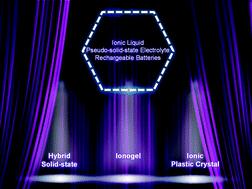当前位置:
X-MOL 学术
›
Energy Environ. Sci.
›
论文详情
Our official English website, www.x-mol.net, welcomes your feedback! (Note: you will need to create a separate account there.)
Pseudo-solid-state electrolytes utilizing the ionic liquid family for rechargeable batteries
Energy & Environmental Science ( IF 32.5 ) Pub Date : 2021-09-15 , DOI: 10.1039/d1ee02567h Jinkwang Hwang 1 , Kazuhiko Matsumoto 1 , Chih-Yao Chen 2 , Rika Hagiwara 1
Energy & Environmental Science ( IF 32.5 ) Pub Date : 2021-09-15 , DOI: 10.1039/d1ee02567h Jinkwang Hwang 1 , Kazuhiko Matsumoto 1 , Chih-Yao Chen 2 , Rika Hagiwara 1
Affiliation

|
The advent of solid-state electrolytes has unearthed a new paradigm of next-generation batteries endowed with improved electrochemical properties and exceptional safety. Amongst them, Li-stuffed garnet type oxides, sulfides, and NASICON type solid-state electrolytes have emerged with fascinating ionic conductivity, electrochemical stability, and high safety standards, besides creating an avenue for using metal anodes to maximize energy density. However, the actual performance of solid-state electrolytes is heavily encumbered by unexpected metal dendrite formation and typically manifests high resistances between the metal electrodes/solid-state electrolytes or grain boundaries, thereby restricting their practical applications. Recent studies have reported several novel approaches, such as modifying solid-state electrolytes using ionic liquids to form the so-called “pseudo-solid-state electrolytes”. This class of electrolytes encompassing materials such as ionogel using ionic liquids and ionic plastic crystals has been gaining rekindled interest for their unique properties that promise great strides in battery performance and diversified utility. This minireview paper summarizes recent progress in pseudo-solid-state electrolytes utilizing ionic liquids, highlighting their fundamental properties while elaborating expedient design strategies. The realistic prospects and future challenges associated with developing pseudo-solid-state electrolyte materials present an insight into their properties to inspire far-reaching exploration into their material characteristics and functionalities.
中文翻译:

利用离子液体家族的可充电电池的伪固态电解质
固态电解质的出现开辟了下一代电池的新范式,具有改进的电化学性能和卓越的安全性。其中,锂填充石榴石型氧化物、硫化物和 NASICON 型固态电解质已经出现,具有迷人的离子导电性、电化学稳定性和高安全标准,此外还为使用金属负极最大化能量密度开辟了道路。然而,固态电解质的实际性能受到意外金属枝晶形成的严重阻碍,并且通常在金属电极/固态电解质或晶界之间表现出高电阻,从而限制了它们的实际应用。最近的研究报告了几种新颖的方法,例如使用离子液体对固态电解质进行改性,形成所谓的“伪固态电解质”。这类电解质包括使用离子液体和离子塑料晶体的离子凝胶等材料,因其独特的特性而重新引起人们的兴趣,这些特性有望在电池性能和多样化用途方面取得巨大进步。这篇小型综述论文总结了利用离子液体的拟固态电解质的最新进展,强调了它们的基本特性,同时阐述了便利的设计策略。与开发伪固态电解质材料相关的现实前景和未来挑战提供了对其特性的洞察,以激发对其材料特性和功能的深远探索。
更新日期:2021-09-22
中文翻译:

利用离子液体家族的可充电电池的伪固态电解质
固态电解质的出现开辟了下一代电池的新范式,具有改进的电化学性能和卓越的安全性。其中,锂填充石榴石型氧化物、硫化物和 NASICON 型固态电解质已经出现,具有迷人的离子导电性、电化学稳定性和高安全标准,此外还为使用金属负极最大化能量密度开辟了道路。然而,固态电解质的实际性能受到意外金属枝晶形成的严重阻碍,并且通常在金属电极/固态电解质或晶界之间表现出高电阻,从而限制了它们的实际应用。最近的研究报告了几种新颖的方法,例如使用离子液体对固态电解质进行改性,形成所谓的“伪固态电解质”。这类电解质包括使用离子液体和离子塑料晶体的离子凝胶等材料,因其独特的特性而重新引起人们的兴趣,这些特性有望在电池性能和多样化用途方面取得巨大进步。这篇小型综述论文总结了利用离子液体的拟固态电解质的最新进展,强调了它们的基本特性,同时阐述了便利的设计策略。与开发伪固态电解质材料相关的现实前景和未来挑战提供了对其特性的洞察,以激发对其材料特性和功能的深远探索。


























 京公网安备 11010802027423号
京公网安备 11010802027423号